Sol Summary – May 4th
Crew 261 Sol Summary Report 04-05-2023
Sol: 4
Summary Title: experiencing Mars is never routine – Focus on Safety (Drill)
Author’s name: Aline Decadi, XO
Mission Status: nominal
Sol Activity Summary: Today took place 2 EVAs:
– EVA-5 with the following crew members: Aline Decadi (XO) (EVA Leader), Audrey Derobertmasure (HSO), Cecile Renaud (GreenHab Officer), Kris Davidson (Crew Journalist)
– EVA-6 with the following crew members: James Burk (Commander) (EVA Leader), Erin Kennedy (Crew Roboticist).
EVA-5 was focused on the initial Meshtastic Testing and on conducting Safety Procedures for EVA Crewmembers.
Each team member carried one Meshtastic: it worked nominally and gave consistent positioning data. This concluded this test successfully. The next tests would be focused to analyze how far we can go from the Hab with this device performing well.
The crew drove with Perseverance and Spirit rovers to explore the Pooh’s Corner, looking for traces of ancient civilizations.
Safety Drill: On our way back, I experienced a possible smell of burnt and alerted the crew and the HabCom I was feeling weak and decided to abort the EVA. The rest of the crew brought assistance on the field removing my Helmet and Backpack, coordinating with the HabCom, and coming back quickly to the Hab for Safety. The overall management of the Safety issue took around 15 minutes. The objectives of the EVA were still reached, and immediate actions were taken while facing danger. A debriefing took place once the crew was safety back to the Hab, and led to a detailed list of the encountered issues from the crew perspectives, and associated outcomes that are deeply detailed in the “EVA Report” of the Sol 4, e.g. regarding coordination & communication management. Some improvements will be also proposed for the next EVAs, e.g. bring water in the rover and fix a water bag/ protein bar on the suit to be able to assist the crew on the field. Experiencing Mars is never routine, and we plan to train for safety procedures during the rest of the mission to learn to act with more confidence: e.g. how to remove very quickly helmet/backpack in case of emergency. The backpack has been checked once coming back at the Hab : no visible sign of damage, and seems functional.
EVA-6 commenced with a thoughtful message from the Commander regarding the three reasons to go to Mars: for the Challenge, for the Science, and for the Future. This certainly gave colour to the present experiment where it could lead to in the future.
EVA-6 conducted Atmosphinder testing with the same size configuration as EVA-4 (half-sized, ~1 m diameter) in front of the Hab with repairs from EVA-4. The objectives of today’s tests focused on leveraging the excellent weather conditions, with wind speeds of 40.2 km/h and wind gusts of 77.2 km/h. The robot was able to be self-propelled by the wind gusts after an initial force assist, travelling approximately 4 meters from its starting position. This was repeated successfully 3 times.
A series of tests were conducted on the sail assembly to determine the amount of sail deflection by the wind with varying servo motor angles. The reactions of the servo motors interacting with the wind gusts were observed. By testing in these unique conditions at MDRS, this gave valuable insight into factors for developing the control system of the sail servo motors. Thank you to the Commander for assisting with the strenuous sail testing.
Final tests involved rolling the robot down a small hill outside the Hab. The robot completed all 3 runs successfully. The electronics payload was functioning separately, collecting environmental sensor data. The EVA-6 worked smoothly, and new information was learned. The success of EVA-6 was again in large part thanks to the entire crew — both on the EVA and behind the scenes!
Look Ahead Plan: We will be in Sim tomorrow: drone testing, according to mission request approval.
Anomalies in work: None.
Weather: Sunny and pleasant. Very windy day.
Crew Physical Status: Nominal.
EVA: One EVA to North West Pooh’s Corner, One EVA in the vicinity of the Hab.
Reports to be filed: HSO Report, EVA Request, EVA Report, Operations Report, Journalist Report, Pictures of the day.
Support Requested: None.
Operations Report – May 4th
Crew 261 Operations Report 04-05-2023 Update #1
SOL: 4
Name of person filing report: Julien Villa-Massone
Non-nominal systems:
· Remote observatory
· Helmet and headset
Notes on non-nominal systems:
· Remote observatory: N/A
· Helmet and headset: See detail below
ROVERS
Spirit rover used: Yes
Hours: (before EVA) 220.3
Beginning charge: (Before EVA) 100
Ending charge: (On return from EVA, before recharging) Not available due to priority given to simulated medical emergency. During second EVA (that did not use rovers), SOC of 81 was noted, while charging.
Currently charging: Yes
Opportunity rover used: No
Hours: 123.0
Beginning charge: 100
Ending charge: N/A
Currently charging: Yes
Curiosity rover used: No
Hours: 232.9
Beginning charge: 100
Ending charge: N/A
Currently charging: Yes
Perseverance rover used: Yes
Hours: 263.1
Beginning charge: 100
Ending charge: Not available due to priority given to simulated medical emergency. During second EVA, SOC of 100 was noted, while charging
Currently charging: Yes
General notes on rovers: Nominal operation today
Summary of Hab operations: Nominal day
WATER USE: rate of 30 gallons / sol. Trend of 28 Gallons/sol since mission start. We are now on target to finish the mission 37 gallons short (or run out 1.2 days early). This means, if we continue with this trend, the tank will be at 118 gallons when the mission ends.
Water (static tank): 349 gallons remaining
Static tank pipe heater (on or off): off
Static tank heater (On or off): off
Toilet tank emptied: no
Summary of internet: Nominal
Summary of suits and radios: Suits and radios:
One helmet is currently unusable due to a few screws being detached, no longer fixing the transparent part of the helmet to the metallic collar. The screws cannot readily be attached again because the metallic collar is damaged where the screws were located, and repair will be required. Crew Engineer does not believe a quick fix is possible, if the goal is not to break again during an EVA. It has been separated from the rest and labeled.
The headset microphone for the CDR’s radio (#1) operated unreliably. There were occasions when the CDR would press to talk and we would only hear static but not his voice. The microphone mounted on the radio functioned properly, so it is a headset / connector issue. Crew Engineer to investigate further when time allows tomorrow.
Summary of GreenHab operations: Nominal. Doors closed early due to wind.
WATER USE: 6 gal at 06:30 + 5 gal at 18:45 + 3 gal for research = 14 gal total
Heater: Off
Supplemental light: Off
Harvest: None
Summary of ScienceDome operations: Nominal. Early growth biostimulation setup.
Dual split: Off
POWER report: Nominal operation, except for a breaker disconnected between a PV string and an MPPT. The same as 2 days ago. Mission Support was alerted and immediately handled this issue. The disconnection happened between 9:27 (time of a photo) and 15:28 (time of discovery).
Summary of RAM operations: Crew Robotics Engineer continued assembly and adjustments of the robot prior to and following a second EVA near the base for testing.
Summary of any observatory issues: Nothing to report
Summary of health and safety issues: Nothing to report
Questions, concerns and requests to Mission Support: The entire crew joins me in thanking Mission Support and the entire Mars Society organization for making such an amazing experience possible.
Journalist Report – May 4th
Crew 261 Journalist Report 04-05-2023
Author: Kris Davidson, Crew Journalist
Deep time is a concept championed by geologists and astronomers, who interpret long-ago events recorded within our Earth’s geological features and far-away planets and stars. This concept allows us to understand the vast and nearly incomprehensible expanse of time that has unfolded since the formation of our universe, as well as the intricate processes that have sculpted the planets in our solar system. By exploring deep time, we gain a humbling appreciation for the enormity of cosmic history and an understanding of how complex, interconnected processes over eons have shaped the Earth and other planets, like Mars, that we aspire to visit soon.
In light of deep time, the brevity of a single human lifetime becomes profoundly apparent. Our fleeting existence, typically spanning less than a century, pales in comparison to the billions of years that have unfolded since the universe’s inception. On Sol 4, during EVA 5, crew members were collecting data for meshtastic devices, walking and admiring Martian geological features when they were suddenly reminded of the ephemeral nature of human life. A mechanical malfunction in a crew member’s spacesuit caused a sudden, brief illness, and in an instant, everything changed. Back at the hab the crew discussed checklists, procedures, and training for better responses in future emergency situations.
Despite the relative brevity of our lives, we still manage to make important contributions to the human race that will endure across a deeper time span. The cumulative nature of human progress, particularly in science and discovery, is a testament to the resilience and tenacity of our species. Each generation builds upon the knowledge and achievements of those who came before, as they seek to unravel the mysteries of the universe, always pushing against the shifting boundaries of our understanding. During EVA 6, crew roboticist Erin Kennedy’s work testing a robotic elements and wind sails of the Atmosphinder rover yielded notable progress. Her work contributes to a larger understanding of how a wind-powered rover intended to provide valuable information about Mars might be best engineered. Meanwhile, in the science dome, Cecile Renaud (greenhab officer and crew biologist) planted tomato seeds in a variety of soil samples to be stimulated later with spirulina, moving us closer to understanding how the first people on Mars might effectively grow food in the planet’s hostile environment.
The collaborative, generational effort in science across time has enabled humanity to make remarkable strides. As we continue to explore the cosmos, we carry with us the collective wisdom of our ancestors. Transatlantic Mars Crew 261 aspires to contribute meaningfully to the ongoing story of human discovery and progress, and on Sol 4 especially, we remain ever mindful of the vast expanse of deep time that surrounds us.
GreenHab Report – May 4th
Crew 261 GreenHab Report 03-05-2023
GreenHab Officer: Cécile Renaud
Environmental control: Door open from 6:30 to 15:30
Average temperatures: 63°F at 06:30, 87°F at 14:00, 84,9°F at 17:40, 82°F at 18:45
Hours of supplemental light: N/A
Daily water usage for crops: 6 gal at 06:30 + 5 gal at 18:45
Daily water usage for research and/or other purposes: 3 gal (including watering solution for biostimulant exp)
Water in Blue Tank 124,2 gallons
Time(s) of watering for crops: 06:30 and 18:45
Changes to crops: N/A
Narrative: Doors are closed early in the afternoon due to the wind. Harvesting of tomatoes will be done on SOL 5
Harvest: (include which crop and mass in grams) : None
Support/supplies needed: None
EVA Report – May 4th
Crew 261 EVA Report 04-05-2023
EVA # 5
Author: James Burk, Commander
Purpose of EVA: Initial Meshtastic Testing + Safety Drill
Start time: 9:00 AM
End time: 10:33 AM
Narrative:
Overview of EVA
Today’s EVA was designed to allow four of our crew to get additional experience with driving rovers and exploring areas within 1km of the Hab, while also testing out our Meshtastic devices for the first time on this mission. Each of the four EVA team members carried a Meshtastic device on their person, and also carried a fifth device in the bed of Perseverance.
The primary objective of the EVA was completed and the devices captured data, which you can see visualized below. The crew did not make it to their planned destination of Gateway to Candor, although that was not a critical part of the EVA. The goal was to give the crewmembers more experience with Rover, Comms, and EVA procedures overall.
Safety Drill
During the last part of the EVA, the crew experienced an anomaly. While exploring an area approximately west of Pooh’s Corner, Executive Officer Aline Decadi started to smell what she described as a “burning plastic smell”. This was confirmed by GreenHab Officer Cecile Renaud who also smelled what she described as a “sulfur smell”. Fearing that XO Decadi’s backpack components were burning, the EVA team quickly worked to take off her helmet and suit. By the time they had done that, XO Decadi started to feel ill, and felt like she was going to faint. She was assisted back to the rovers by the three other crewmembers: GreenHab Officer Renaud, HSO Audrey Derobertmasure, and Crew Journalist Kris Davidson.
The crew has been carrying a Garmin inReach mini 2 on all EVAs, which has a custom “MDRS Assistance Required” feature, that is meant to alert the Hab, Mission Support or local county EMS in the case of an emergency or when assistance is needed. In this case, GreenHab Officer Renaud triggered the feature immediately and it was seen by HabCom within a couple minutes on our custom EVA monitor.
The crew experienced issues with comms throughout the EVA, which compounded the situation. At one point, one of the two rovers drove off while the other had not yet started, which was due to Comms issues.
The EVA team then proceeded back to the Hab safely.
The team performed a debriefing session and many issues were raised and discussed. A list of them is below. We also created a set of “Outcomes”, or recommendations, for both our crew’s future operations and the program in general.
Overall, the crew felt this was a great learning experience. The team debriefing session, while sometimes quite heated, overall was a very productive and constructive discussion.
Issues Experienced During EVA 5
- [Technical] XO Decadi’s EVA gear seemed to create a smell that made her sick, briefly.
- [Medical] XO Decadi experienced light-headedness due to issue #1. At one point, she was leaning hard on the other crewmember and felt like she was going to faint.
- [Procedural] When individual crewmembers experienced Comms issues, not all crewmembers worked together to resolve them.
- [Procedural] Rovers should stay together at all times, and certainly within sight of each other. One rover should never be out of sight of the other.
- [Procedural] Crew members should be careful not to talk at the same time, because it interferes with Comms and makes it so nobody is heard. This happened often on this EVA.
- [Procedural] Crew members should switch to Channel 2 when having comms issues between each other. One crewmember stayed on Channel 1 during the entire EVA, despite the Comms issues.
- [Procedural] Removing XO Decadi’s helmet in an emergency situation was done in a suboptimal way.
- [Technical] Our Garmin device did not trigger an email to Mission Support, as was designed. We are investigating this problem.
- [Procedural] It is safer to go to the furthest point of the EVA and then work your way back closer to the Hab. Instead, the EVA team first stopped near Marble Ritual and then north of Pooh’s Corner, with the intent to eventually get to Gateway to Candor. Instead they should have driven all the way to Gateway and worked their way back in the direction of the Hab.
Outcomes
- Air flow of a backpack can be left on while the helmet is removed. In today’s case it was rightly switched off by one crew member while two others were removing the helmet, because of the nature of the perceived issue (burning component in backpack). In other emergency cases, keeping air flow on would be desirable
- We need more hand signals, especially to communicate comms outages or when driving a rover with a sick crewmember in passenger seat (ie, “Are you ok?”)
- Crewmembers should always carry water on their person, and there should be at least one emergency water bottle carried by the EVA crew in the rover. By utilizing a carabiner clip with a water bottle that has a loop at the top, a crewmember can easily stow it on their person so that both hands are free.
- EVA members should have a mandatory water break every 20-30 mins, to keep ahead of any thirstiness or dehydration. We have noticed this can creep up on you quickly, and we keep powering through minor thirstiness only to suffer severe thirst later in the EVAs. Often, peer pressure or psychology prevents people from being the first to pause the EVA for reasons like this.
- When two rovers are driving, the person driving the rover should communicate with the other rover driver, and the other two (passenger) crew members should remain quiet.
- There should be a mandatory comm check at the beginning of every traverse. In today’s case, one rover lead was trying to communicate with the other, but they were not heard.
- The EVA suits should support rapid removal of helmet and backpack battery in the case of an emergency.
- EVA teams should carry sugar packets to help ill crew members. In today’s case that would have helped.
- For our crew’s HSO, the threshold for breaking sim would have been an actual fainting, not an “almost” fainting. In today’s case, the incident did not meet the threshold, although we broke the sim anyway due to the backpack smell issue.
- We should perform drills to practice self-removal of the helmet and backpack in an emergency.
Destination: Gateway to Candor.
Coordinates (use UTM WGS 84): 519000 E, 4251700 N
Participants: Aline Decadi (XO) (EVA Leader), Audrey Derobertmasure (HSO), Cecile Renaud (GreenHab Officer), Kris Davidson (Crew Journalist)
Road(s) and routes per MDRS Map: Drive to Cow Dung Road, then drive north to Gateway to Candor. Walk on foot to explore area.
Mode of travel: Rovers (Perseverance and Spirit)
Crew 261 EVA Report 04–05–2023
EVA # 6
Author: James Burk, Commander
Purpose of EVA: Testing of Atmosphinder prototype with wind sails and improvements since EVA #4
Start time: 12:00 PM
End time: 2:00 PM
Narrative:
This EVA was conducted during extremely strong (~30-52 kph) winds outside the Hab, which were very desirable for the type of testing that we aimed to perform.
EVA-6 conducted Atmosphinder testing using the half-sized robot (~1 m diameter) in front of the Hab. The objectives of the test focused on structural aspects of the robot and de-risking operational elements. The EVA crew members worked together to increase the operational understanding of extracting the full-scale body of Atmosphinder, a prototype sail, and the science payload, that was used for previous EVAs, which collects various data. Like EVA-4, the lessons learned from this exercise will de-risk these elements on future EVAs when transporting the robot to regions of interest.
There were three separate rounds of tests conducted including testing the sail for the first time, which was done by Commander James Burk holding the sail while pulling it apart with his two arms, while Crew Roboticist Erin “RobotZwrrl” Kennedy manipulated the robot’s servos and positioned the sail in various configurations to see the effects that the strong wind gusts would have on the materials and engineering design.
Qualitative testing observed, again as with EVA-4, that the robot can roll down a small incline unassisted, and this was performed on a larger slope than EVA-4 and for multiple runs. It was expected that this test would be destructive, but the robot’s structure held together well.
The science payload was also positioned in several locations and data on the wind speed was gathered.
All tests were performed successfully and valuable new information was learned. The crew journalist and EVA team lead also took photos and recorded video footage for public outreach and internal review purposes.
Destination: Flat ground just outside the hab.
Coordinates (use UTM WGS 84): 518100 E, 4249900 N
Participants: James Burk (Commander) (EVA Leader), Erin Kennedy (Crew Roboticist).
Road(s) and routes per MDRS Map: Walking outside between the Hab and RAM.
Mode of travel: Walking. No Rover driving performed; Use of Rover Bed only for this EVA.



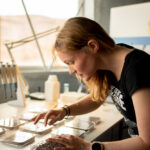
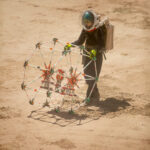
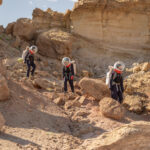
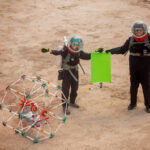
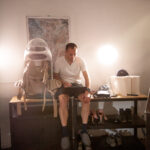

You must be logged in to post a comment.